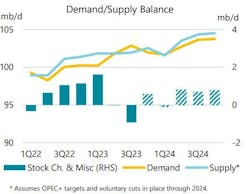IEA: Oil demand growth to slow in 2024 while supply to hit new high
Global oil demand growth decelerated to 1.7 million b/d year-on-year (y-o-y) in fourth-quarter 2023, significantly lower than the 3.2 million b/d rate observed in the second and third quarters of the same year, mirroring the unwinding of China’s post-pandemic release of travel demand, the International Energy Agency (IEA) said in the January 2024 Oil Market Report (OMR).
IEA’s projections indicate a further easing of growth to 1.2 million b/d in 2024 from 2.3 million b/d in 2023. This deceleration is attributed to macroeconomic challenges, stricter efficiency standards, and the increasing presence of electric vehicles.
“Over the course of 2023, the pace of demand growth outside of China slowed significantly, to around 300,000 b/d on average during second-half 2023. China will continue to lead oil demand growth in 2024, with its expanding petrochemical sector gaining an ever-larger share,” IEA said.
World oil supply is anticipated to increase by 1.5 million b/d, reaching a record high of 103.5 million b/d in 2024. This surge is fueled by record-setting output from the US, Brazil, Guyana, and Canada. Non-OPEC+ production is expected to drive growth, accounting for nearly 1.5 million b/d. In contrast, OPEC+ supply is projected to remain relatively stable compared to the previous year, assuming extra voluntary cuts that started in January 2024 are phased out gradually in the second quarter.
“At the start of 2024, the risk of global oil supply disruptions from the Middle East conflict remains elevated, particularly for oil flows via the Red Sea and, crucially, the Suez Canal. In 2023, roughly 10% of the world’s seaborne oil trade, or around 7.2 million b/d of crude and oil products, and 8% of global LNG trade passed through this major trade route. The main alternative shipping route around Africa’s Cape of Good Hope extends voyages by up to 2 weeks – adding pressure on global supply chains and boosting freight and insurance costs,” IEA said.
Barring significant disruptions to oil flows, the market looks reasonably well supplied in 2024, IEA added.
Refining, oil inventory
The discrepancy in regional refinery profitability narrowed further in December 2023 as margins weakened in the Atlantic Basin but strengthened in Singapore, according to IEA. Refinery crude throughputs are forecasted to average 83.3 million b/d in 2024, surpassing the previous record of 82.5 million b/d in 2018. However, the gap between OECD and non-OECD runs will continue to widen due to new capacity additions in the Middle East, Africa, and China.
Global observed oil inventories decreased by 8.4 million bbl in November 2023, reaching their lowest level since July 2022. Crude oil and middle distillates were notably tight. A decline in oil on water (-12 million bbl) was partially offset by on-land stock builds (+3.6 million bbl). Oil products saw a substantial decrease of 24.6 million bbl, while crude oil inventories rose by 16.2 million bbl. Preliminary data suggests that global inventories increased in December, driven by a surge in oil on water.
Russian oil exports
Russian oil exports increased by 500,000 b/d to a 9-month high of 7.8 million b/d in December 2023, IEA data shows. Crude shipments rose by 240,000 b/d month-on-month (m-o-m) to 5 million b/d, and product flows increased by 260,000 b/d. Despite this, estimated export revenues declined to a 6-month low of $14.4 billion, attributed to increased Russian oil price discounts and a drop in benchmark oil prices.
